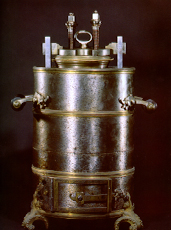
45 x 18.7 x 26.3
Bronze, wood and iron
INDEX 1788 : O.V.269
Digestor Papini aeneus, cujus operculum crassis clauditur, et retinetur ferramentis, emolliendis corporibus serviens vaporum aquae rarefactorum ope, et ad hujusce Machinae usum. Clibanus ferreus cum craticula, et tripoide mobili, in quo ponuntur cabones accensi.
Papin's digester in bronze, with a lid which is closed and held in place by thick pieces of iron, which serves to soften matter with the help of rarefied water vapour. An iron oven with a little grill and a movable tripod into which lighted coals can be placed.
This instrument consists of an iron cylinder, with a wooden handle on either side, seated on a circular base of the same diameter. This base, that serves as a little furnace, is perforated in the upper part and has a little door at the front where the fuel is introduced. Inside the cylinder, and over the perforated part of the furnace, a second cylinder is placed, a little higher than the first, which Papin called a digester. This cylinder is made of bronze with 3 cm thick walls. It is hermetically sealed by a circular lid. A circular piece equipped with four vertical screws allows the lid of the digester to press strongly against the top of the cylinder. For this, the lid possesses two lateral catches where two iron bars are encased. These bars also pass through two catches on the lateral wall of the digester. The whole thing is very robust.
This device allowed the heating of water to a temperature higher than boiling point at atmospheric pressure, consequently reaching considerably high pressure inside. In 1680 Papin designed a model of digester that allowed a piston inside a cylinder to move as a result of the action of the steam pressure produced by the heating of the water.
One of the uses of the digester in the experimental physics lessons, was to soften bones owing to the high temperature inside the cylinder.
In 1911 the furnace was sold at a sadly remembered auction which, consequently, deprived the Gabinete de Física of magnificent pieces of its collection. Professor Mário Silva, in his important work restoring the Gabinete de Física, found this piece in a plumber's workshop, in extremely bad condition and almost unrecognisable. Despite the doubts of the proprietor, Professor Mário Silva managed to reacquire it, replacing it with what remained of the splendid collection of teaching instruments with which the Gabinete was founded.
From Colégio dos Nobres, catalogue n.º 259.Silva, Mário da, "Um Novo Museu em Coimbra: O Museu Pombalino da Faculdade de Ciências da Universidade", Revista da Faculdade de Ciências da Universidade de Coimbra, Coimbra, n.º 1, Vol. VIII, pp. 129-154.